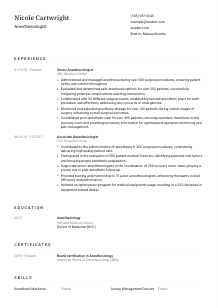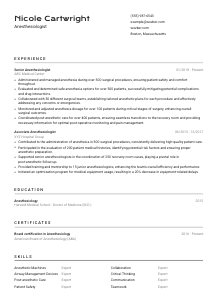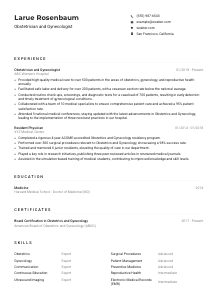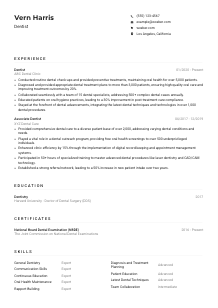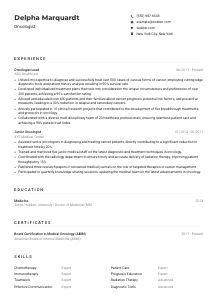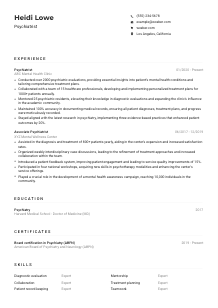Anesthesiologist CV Example
Blending drugs with medical drama, but your CV feels unruffled? Explore this Anesthesiologist CV example, synchronized with Wozber free CV builder. See how effortlessly you can match your clinical finesse with job expectations, ensuring your career stays sedation-free and consistently at the forefront of healthcare!
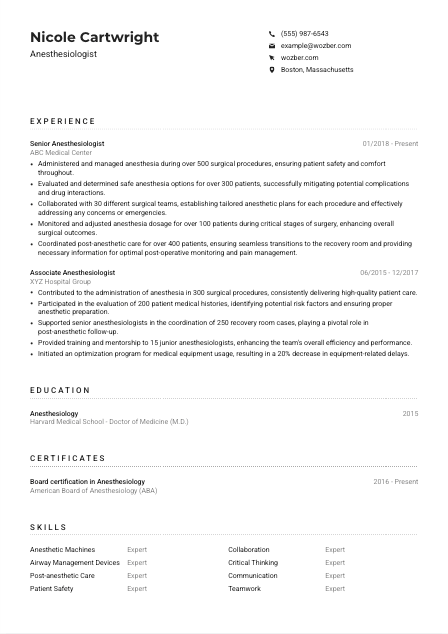
How to write an Anesthesiologist CV?
As an Anesthesiologist stepping into the competitive medical field, your CV isn't just a piece of paper—it's a window into your professional soul. Armed with Wozber, a free CV builder designed to craft a compelling ATS-compliant CV, you're about to transform your career narrative into an irresistible appeal to hiring managers. This guide, rich with profession-specific insights and encouragement, will navigate you through creating a CV that's just as precise and impactful as your role in the operating room. Let's dive into the art of CV crafting, tailored specifically for the Anesthesiology profession.
Personal Details
The Personal Details section is your handshake in print. It's your chance to make a striking first impression without saying a word. Let's ensure this section speaks volumes about who you are as an Anesthesiologist.
1. Name with Precision
Think of your name as the title of your professional story. Make it bold and unmissable. This isn't just about font size—it's about setting the stage for your narrative. Your name is a declaration of your professional identity, so let it shine from the top of your CV.
2. Job Title Clarity
"Anesthesiologist"—placing the title you're applying for beneath your name instantly forms a connection with the job you're targeting. It's a subtle yet powerful way to align your CV with the expectations of the hiring manager right from the get-go.
3. Essential Contact Details
Include your phone number and professional email—these are your lifelines for potential contact. Double-check them for accuracy. A mistyped digit or a casual email handle can lead to missed opportunities. Ensure your email reflects professionalism; something simple like firstname.lastname@email.com speaks volumes.
4. Location Specifics
Indicating you're based in "Boston, Massachusetts," directly aligns with the job's location requirement, subtly reassuring the employer of your availability and reducing potential relocation concerns. This level of detail shows you're not just ready for the job, but you're logistically prepared for it too.
5. Relevant Online Presence
If you possess a LinkedIn profile or a professional website, include it. Make certain it's up-to-date and mirrors the professionalism of your CV. This can be a powerful tool to showcase your broader professional narrative beyond the constraints of a CV.
Takeaway
A well-crafted Personal Details section serves as your professional greeting. It's concise yet complete, offering just the right amount of information to intrigue and assure hiring managers of your fit for the role. Aim for clarity, relevance, and a touch of character.





Experience
The Experience section is where your CV comes to life, showcasing your journey through the world of Anesthesiology. It's your platform to demonstrate how your specific experiences make you the ideal candidate for the job.
- Administered and managed anesthesia during over 500 surgical procedures, ensuring patient safety and comfort throughout.
- Evaluated and determined safe anesthesia options for over 300 patients, successfully mitigating potential complications and drug interactions.
- Collaborated with 30 different surgical teams, establishing tailored anesthetic plans for each procedure and effectively addressing any concerns or emergencies.
- Monitored and adjusted anesthesia dosage for over 100 patients during critical stages of surgery, enhancing overall surgical outcomes.
- Coordinated post‑anesthetic care for over 400 patients, ensuring seamless transitions to the recovery room and providing necessary information for optimal post‑operative monitoring and pain management.
- Contributed to the administration of anesthesia in 300 surgical procedures, consistently delivering high‑quality patient care.
- Participated in the evaluation of 200 patient medical histories, identifying potential risk factors and ensuring proper anesthetic preparation.
- Supported senior anesthesiologists in the coordination of 250 recovery room cases, playing a pivotal role in post‑anesthetic follow‑up.
- Provided training and mentorship to 15 junior anesthesiologists, enhancing the team's overall efficiency and performance.
- Initiated an optimisation program for medical equipment usage, resulting in a 20% decrease in equipment‑related delays.
1. Dissect Job Requirements
Align your experience with the job's requirements. If the position demands "administering and managing anesthesia during surgical procedures," illustrate how you've excelled in this area with specific examples, such as the number of successful procedures you've overseen.
2. Structure and Detail
Start with your most recent role, showcasing your progression in the field of Anesthesiology. Detail your job title, the name of the institution, and your tenure. It's a clear, organized way to lead the hiring manager through your professional journey.
3. Tailored Accomplishments
For each role, highlight your achievements. Did you develop an innovative anesthetic plan? Reduce post-operative recovery times? These specifics offer a vivid picture of your skills and impact in real-world scenarios, directly reflecting the job's responsibilities.
4. Quantify Impact
Using numbers to quantify your contributions can dramatically elevate your CV. Mentioning you've "Administered anesthesia in over 500 surgeries with a 99% success rate" provides tangible proof of your excellence and reliability in the field.
5. Relevance is Key
Focus on experiences directly connected to the role of an Anesthesiologist. This isn't the place for unrelated achievements. Each bullet point should be a stepping stone that builds towards the picture of an ideal candidate.
Takeaway
Crafting an Experience section that's compelling and targeted is like presenting a case study on your professional life—it shows not just what you've done, but how what you've done is perfectly suited for the role you're aspiring to. This is your chance to make the hiring manager see you not just as a candidate, but as the solution to their needs.
Education
In the world of Anesthesiology, your educational background is a testament to your foundation in the field. It shapes the lens through which hiring managers view your technical capabilities. Let's make sure it showcases your qualifications effectively.
1. Identify Essential Qualifications
Reflect the job's educational requirements in your CV. If it states a need for a "Doctor of Medicine (M.D.) or Doctor of Osteopathic Medicine (D.O.) degree," ensure your education section clearly lists your relevant degree, mirroring the language used in the job description.
2. Clear, Concise Layout
Organize your educational background in a straightforward manner. Start with your advanced degrees and work backward. For each, provide the degree, field of study, institution, and graduation date. Clarity here reinforces the strength of your academic foundation.
3. Degree Alignment
Specifically listing your specialization in Anesthesiology within your degree (if applicable) or highlighting your residency in Anesthesiology connects your education directly to the job you're applying for, underscoring your relevant expertise.
4. Relevant Courses and Honors
Including particulars about specialized courses or honors can further distinguish your candidacy, especially if they directly relate to skills or knowledge essential for the Anesthesiologist role. This optional detail can provide depth to your educational narrative.
5. Additional Achievements
Were you part of a medical society or did you engage in research during your studies? Such involvement shows a commitment to your field beyond the classroom, illustrating both a passion for Anesthesiology and a drive for continuous learning and contribution.
Takeaway
Your educational background shouldn't just tick the boxes of requirements—it should highlight the depth and breadth of your preparation for a career in Anesthesiology. From your degrees to your engagements, make this section a clear reflection of your specialized knowledge and commitment.
Certificates
In the world of Anesthesiology, certifications can be the fine line that separates the good from the great. They're not just credentials; they're your badge of ongoing professional development and expertise.
1. Pinpointing Essential Certifications
Start by ensuring your CV features required certifications, like the "Board certification in Anesthesiology from the American Board of Anesthesiology (ABA)." This not only meets a critical job requirement but also signals high professional standards.
2. Highlight Relevant Certificates
Focus on certifications that resonate with the Anesthesiologist role. While 'Basic Life Support (BLS)' might be a given, it's a vital inclusion, underscoring your preparedness for any situation. Quality over quantity allows the most relevant credentials to shine.
3. Dates and Details Matter
For certifications with validity periods, such as your 'Board certification in Anesthesiology,' include the dates of issuance and expiry (if applicable). This keeps your CV current and lets hiring managers know your qualifications are up to date.
4. Continuous Professional Development
Show a commitment to staying at the forefront of Anesthesiology through ongoing education. Recertifications, advanced courses, and additional credentials pertaining to specialized areas within Anesthesiology can set you apart as a dedicated professional.
Takeaway
In a field that evolves as dynamically as medicine, certifications are your proof of excellence and dedication to staying ahead. Highlighting these credentials in your CV speaks volumes about your commitment to providing the best care through continuous learning.
Skills
In Anesthesiology, your skills set the stage for your success in the operating room and beyond. Here, you'll showcase your technical finesse alongside your ability to navigate the complexities of patient care with empathy and precision.
1. Decode and Align
Review the job listing and note skills directly mentioned, like 'patient safety' and 'teamwork.' These aren't just keywords; they're a critical part of your professional identity. Your ability to tailor this section to reflect those mentioned terms broadly elevates your relevance for the role.
2. Balance of Hard and Soft Skills
Anesthesiology demands a blend of technical ability and soft skills. Show proficiency in using 'anesthetic machines' and 'airway management devices,' while also highlighting 'critical thinking' and 'communication.' It's the balance between these that make an Anesthesiologist truly exceptional.
3. Precision and Prioritization
While the temptation may be to list every skill you possess, focus on those most pertinent to the role. Ensure each skill you include directly contributes to painting a picture of you as the ideal Anesthesiologist for the job. Jettison the rest to keep your CV sharp and focused.
Takeaway
Curating your skills for your CV is both an art and a science. It requires a strategic selection that highlights not only your technical prowess but also your adaptability and interpersonal strengths. This nuanced showcase can significantly impact how hiring managers perceive your candidacy.
Languages
In a field as diverse and global as Anesthesiology, being able to communicate effectively across linguistic barriers can be a distinct advantage. Here's how to highlight your linguistic skills in a way that enhances your professional appeal.
1. Job Language Requirements
Always start by aligning with the job post's requirements. If 'must be conversant in English' is listed, ensure 'English: Native' tops your language section. This direct match highlights your readiness to meet the foundational communication needs of the position.
2. Additional Languages
If you speak other languages, list them in descending order of proficiency after meeting the primary language requirement. This showcases your versatility and readiness to engage with a diverse patient demographic, potentially setting you apart from other candidates.
3. Honest Assessment
Be accurate in your self-assessment of language skills. Utilize terms like 'fluent,' 'intermediate,' and 'basic' to describe your proficiency levels. This honesty reflects integrity and helps set realistic expectations for your role within a medical team.
4. Role-Specific Language Skills
While not explicitly called for in every job description, the ability to speak languages in addition to English, such as Spanish, can significantly enhance your appeal in locations with a broad patient base. It showcases a commitment to patient care and communication.
5. Global Citizen
In a profession that often crosses borders, both literally and figuratively, your linguistic abilities are more than just a CV filler—they're a testament to your capacity as a global healthcare provider. Embrace this narrative of connectivity and competence.
Takeaway
Your ability to communicate in multiple languages is a powerful tool in the field of healthcare. It's not just about the words spoken but the comfort and trust you can build with patients and colleagues. Let your language skills shine as part of your unique professional identity.
Summary
Your summary is the opening statement of your professional story. It sets the tone for everything that follows, providing a snapshot of your career and the unique qualities that make you the ideal Anesthesiologist for the job. Let's craft a summary that captures attention and articulates your value.
1. Capture the Job's Essence
Begin by understanding the core of what the job entails and what the employer values. For an Anesthesiologist, this might mean emphasizing skills in 'patient safety,' 'anesthetic management,' and a history of successful collaborations with surgical teams.
2. A Strong Opening
Start with an assertive, engaging introduction that speaks to your professional identity and scope of experience. For example, 'An Anesthesiologist with over 6 years of dedicated experience in...,' immediately signals your expertise and commitment.
3. Addressing the Needs
List your standout skills and notable accomplishments, focusing on those that align with the job's requirements. This could include 'administering anesthesia in over 500 surgical procedures' or 'tailoring anesthetic plans,' directly echoing the responsibilities listed in the job description.
4. Brevity and Impact
While the urge to include every detail of your career might be strong, the key to a powerful summary is conciseness. Aim for 3-5 impactful lines that leave the hiring manager eager to learn more about you and your professional journey.
Takeaway
Think of your summary as the elevator pitch of your professional self. Within a few lines, you need to convey your expertise, your approach to patient care, and your fit for the Anesthesiologist role. It's your first opportunity to differentiate yourself, so make it count with precision and passion.
Embarking on Your Anesthesiologist Career Path
With these insights and the power of Wozber's free CV builder at your fingertips, you're ready to craft an ATS-friendly CV that speaks volumes. Remember, your CV is more than a list of accomplishments—it's the narrative of your professional journey, tailored to the Anesthesiologist role you aspire to. Use it as a tool not just to seek opportunities but to illuminate your path in the ever-evolving world of healthcare.
Your next step is within reach, and the operating room awaits your expertise. Embrace this moment, and let your CV be the key that opens doors to a fulfilling career.

- Doctor of Medicine (M.D.) or Doctor of Osteopathic Medicine (D.O.) degree from an accredited institution.
- Completion of a residency program in Anesthesiology, typically lasting four years.
- Board certification in Anesthesiology from the American Board of Anesthesiology (ABA) or the American Osteopathic Board of Anesthesiology (AOBA).
- Minimum of three years of clinical experience in anesthesiology practice.
- Strong proficiency in using medical/surgical equipment, including anesthetic machines, monitors, and airway management devices.
- Must be conversant in English.
- Must be located in Boston, Massachusetts.
- Administer and manage anesthesia given during surgical procedures, ensuring patient safety and comfort.
- Evaluate patient medical history to determine safe anesthesia options, taking into consideration potential complications and drug interactions.
- Monitor patient's vital signs and adjust anesthesia dosage as necessary throughout the procedure.
- Collaborate with surgical teams to establish anesthetic plans and address any concerns or emergencies that may arise during surgery.
- Coordinate post-anesthetic care with the recovery room staff, providing necessary information for patient post-operative monitoring and pain management.





